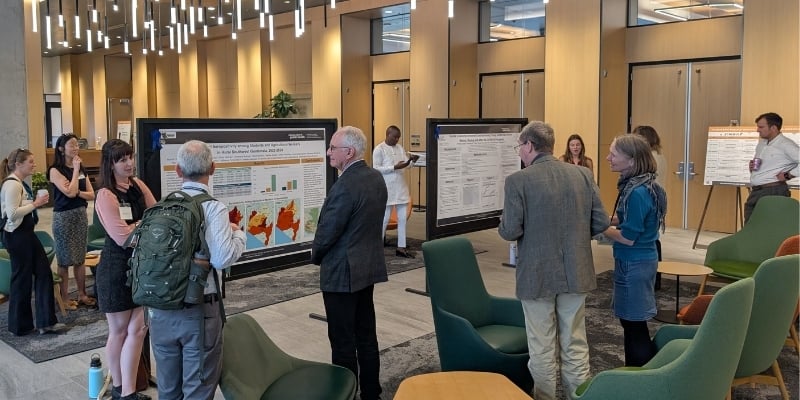The San Luis Valley sits between two major mountain ranges—the San Juans and the Sangre de Cristos—in south-central Colorado. As the upper headwater region for the Rio Grande River, the San Luis Valley is a fertile and important agricultural part of the state, supporting the majority of Colorado’s potato and buckwheat crop.
However, the region’s natural geology has also contributed to elevated environmental levels of heavy metals, and in turn made it a historical hot spot for the mining of gold, silver and lead. There are many abandoned mining sites throughout the valley, two of which have been designated as Superfund sites by the U.S. Environmental Protection Agency due to their potential hazards to human health .
These mining sites release heavy metals into the environment, which can cause a wide range of health impacts in the short term, such as skin and eye irritation and respiratory stress, as well as in the long term, through impacts on the cardiovascular system that lead to high blood pressure and other forms of cardiovascular disease. Some heavy metals, such as lead, cadmium and manganese, are also associated with declines in neurocognitive function. Exposure to heavy metals during pregnancy is particularly concerning as it may increase the risk of miscarriage, or adversely impact the physical and neurocognitive health of the child.
San Luis Valley (SLV) community members are very aware of the environmental impacts of mining. They have led their own sampling campaigns in the region, been active in conversations about public health policy and water management, and pushed for more research on the health effects of exposure to heavy metals.
Heavy metals in mothers and newborns
The Community Engagement Core of the Metals and Metal Mixtures, Cognitive Aging, Remediation, and Exposure Sources (MEMCARE) study seeks to lead a community science and sampling effort in the SLV. The team is led by Kathy James, PhD, MSPH, MSCE, and Francesca Macaluso, MPH, from the Department of Environmental and Occupational Health and the Center for Health, Work & Environment at the Colorado School of Public Health. They work with pregnant participants to collect water, soil, and urine samples throughout the pregnancy and after delivery, as well as nail samples from newborns, to better characterize how heavy metal exposure changes over time and how maternal exposure impacts newborns.
The team is particularly interested in heavy metals like arsenic, lead, uranium, and manganese, which are both significant environmental contaminants in the region, as well as metals that may result in neurocognitive health impacts later in life.
This project is done as part of the MEMCARE Superfund Research Center (SRC) based out of Harvard University, in partnership with internal partners at Arizona State University, partners from the Columbia Trace Metals Laboratory, and local SLV community partners including the San Luis Valley Ecosystem Council, SLVHealth, and Silver Thread Public Health. While they are still recruiting for this study, the team has analyzed seven complete sets of samples from participants and found as many as 17 heavy metals.
So far, no water metal concentrations have been above the EPA maximum contaminant levels, but some participants have urinary levels that exceed the 50th or 90th percentiles in nationally representative studies, indicating that these exposures have significant consequences even at observed levels.
Their preliminary analyses show a relationship between maternal urine concentrations of arsenic, uranium, and manganese and concurrently collected water concentrations – the higher a pregnant person’s water levels of metals are, the higher the concentrations of metals in their urine samples are at a given timepoint. Similarly, newborn nail arsenic concentrations also appear to be moderately correlated with concurrent maternal urine levels, suggesting that higher levels of metals in a pregnant person’s urine after delivery are linked with higher levels of heavy metals in their newborn’s body.
“While the sample size is small, these findings are indicative of lifetime and likely multi-generational burdens from metals exposure that have consequences for health throughout life,” said Macaluso.
Highly exposed and underserved
The team is characterizing environmental exposure to heavy metals in a highly exposed, underserved community that is motivated to learn steps they can take to reduce personal exposure, especially during sensitive windows of personal health like pregnancy.
“Addressing environmental exposures in more remote, rural areas is a complex problem,” said James. “A large proportion of the SLV relies primarily or solely on well water, which is not subject to the same environmental regulation (and therefore not entitled to the same regular quality testing and treatment) as municipal water systems.”
The relationships between arsenic and manganese water levels and maternal urine have implications for maternal cardiovascular and neurological health. In-utero, exposure to arsenic may be linked to poorer infant outcomes, including preterm birth and low birth weight. Community members are concerned about their experiences of high miscarriage rates and therefore understanding what exposures might be contributing to that is key to improving maternal and child health.
The team hopes to identify the possible sources of exposure, especially within the household, with the goal of providing current participants and the community with information to better protect their health and reduce the impacts of heavy metal exposure throughout their lives. Partners from Arizona State are using the findings to develop a targeted water filter for region-specific heavy metals.



-Jan-30-2024-05-49-32-6355-PM.jpg)




